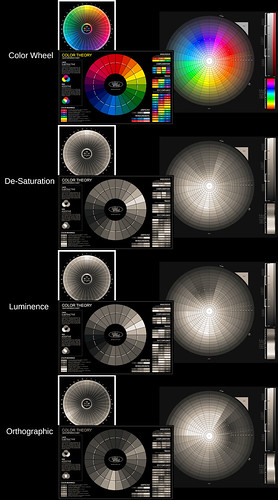Someone who's work I'm following and who's PhD thesis on pictorialist lenses I've closely read posted something that captured my attention. I find it very charming. As you can see from the EXIF it is an image made using an old single coated lens Zeiss Ikonta B film camera using Orthographic film.
Ortho film is very sensitive to blue light, minimal sensitivity to green, and zero sensitivity to red. It can produce a distinctive "look." In fact, this was the way all black and white images were before the invention of panchromatic film that was sensitive somewhat equally to all visible colors in the spectrum in the early part of the 20th century.
Working in digital and using color channels we can emulate Orthographic film. The recipe is very simple. Set the color channels in your processing software's Black and White conversion module as follows.
- Blue - 100
- Green - 33
- Red - 0
Simple as that.
In the following example we can see the original color wheels in color. This is followed by the color wheels de-saturated. This method is what I thought digital cameras used to generate/process in-camera black and white images. Afterall, it's how panchromatic film (more or less) works.
Happily Sony proved me very wrong on this point. But it is the only method available to Leica in their black and white only cameras. In this sense Leica black and white images are no better than using old panchromatic film.
After that comes the human perception model luminance color conversion. Remember that the human eye perceives same energy colors differently. We see blue darker than we see same energy green. This is how, in black and white photography, we can begin to see what photographers call "tonal separation."
As I said, Sony's in-camera black and white images don't simply desaturate a scene. They use, instead, this human perception model conversion. It's brilliant, actually. Tonal separation in-camera. Now who would've thought? :-)
Finally, we will see how the Orthographic film emulation effects the outcome of the color wheel conversion. Pay close attention to the visual intensities between colors. Things change pretty obviously compared with the prior two black and white conversion methods. Using this approach, perhaps we can begin to emulate the "look" of pre-panchromatic film images? Let's have a look, shall we?

Coming back to my friends work for a moment, is what makes his images charming the old Zeiss Ikonta B camera and its uncoated lens?
Is it the Ilford Orthographic film that he uses that makes his images so wonderful?
Perhaps, is it the processing chemicals that he's using and the subtle grain his images have?
Is it a combination of these things, or something else entirely?
No comments:
Post a Comment